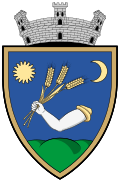Valea lui Mihai
|
Valea lui Mihai Érmihályfalva |
||||
|
||||
| Basic data | ||||
|---|---|---|---|---|
| State : |
|
|||
| Historical region : | Screeching area | |||
| Circle : | Bihor | |||
| Coordinates : | 47 ° 31 ' N , 22 ° 8' E | |||
| Time zone : | EET ( UTC +2) | |||
| Height : | 138 m | |||
| Area : | 73.45 km² | |||
| Residents : | 9,902 (October 20, 2011) | |||
| Population density : | 135 inhabitants per km² | |||
| Postal code : | 415700 | |||
| Telephone code : | (+40) 02 59 | |||
| License plate : | bra | |||
| Structure and administration (as of 2016) | ||||
| Community type : | city | |||
| Mayor : | József Nyakó ( UDMR ) | |||
| Postal address : | St. Calea Revoluției, no. 2 loc. Valea lui Mihai, jud. Bihor, RO-415700 |
|||
| Website : | ||||
Valea lui Mihai (formerly Mihaifalău , Hungarian Érmihályfalva , Nagymihályfalva, Mihályfalva ) is a city in Bihor County in Romania .
location
Valea lui Mihai is located in the Kreisch area on the eastern edge of the Great Hungarian Plain . The district capital Oradea is located about 55 km south, the Hungarian border only about 7 km west.
history
Valea lui Mihai was first mentioned in a document in 1270. At that time it belonged to the Kingdom of Hungary . In 1312 the place received the right to collect tariffs from the Hungarian King Karl I. Markets have been allowed to be held since 1459. In 1587 the Turks set Valea lui Mihai on fire and drove the residents to flight. Since the end of the 17th century the place belonged to Austria-Hungary . In 1844 and 1930 Valea lui Mihai was declared a city, but lost this status again after a while. After 1867, the place under its Hungarian name Érmihályfalva became the seat of a chair district in Bihar County . The food industry developed at the end of the 19th century. At the end of the First World War , Valea lui Mihai came to Romania despite the Hungarian majority, and was then part of Hungary again from 1940 to 1944 as a result of the Second Vienna Arbitration . Since 1989 the place has been a city again.
In addition to the food industry, there are also agriculture, trade, textile and wood processing industries.
population
In the 16th and 17th centuries - at the time of Turkish rule - the population was very small. In 1800, 1594 inhabitants were registered.
In 1880, 3896 people lived in today's city, 3580 Hungarians , 85 Ukrainians , 47 Germans , 14 Slovaks and 14 Romanians . Jews were usually registered as Hungarians. In 1930, of the then 8,085 inhabitants, 5,314 identified themselves as Hungarians, 1,428 as Jews , 1,194 as Romanians, 90 as Roma and 25 as Germans. In 1956 the number of Jews had dropped to 156. The 2002 census recorded 10,324 residents in Valea lui Mihai, including 8,757 Hungarians, 1,442 Romanians, 95 Roma and 10 Germans.
traffic
In 1871 the railway line from Debrecen to Satu Mare through Valea lui Mihai went into operation ; In 1887 the town became a railway junction with the construction of the line to Oradea. Express and local trains to Oradea and Satu Mare stop in the city. Cross-border rail traffic to Hungary is also important; There are currently (2013) three through regional trains running to and from Debrecen per day, they stop at the border for one hour. The European route 671 also runs through Valea lui Mihai .
Attractions
- Acacia forests
- Historical-ethnographic museum
Personalities
- Zoltán Zelk (1906–1981), Hungarian writer
Partnerships
Web links
Individual evidence
- ↑ 2011 census in Romania ( MS Excel ; 1.3 MB)
- ↑ a b c website of the city ( memento of February 9, 2012 in the Internet Archive ), accessed on January 18, 2009
- ↑ 2002 census, accessed on January 19, 2009 (PDF; 1.1 MB)



